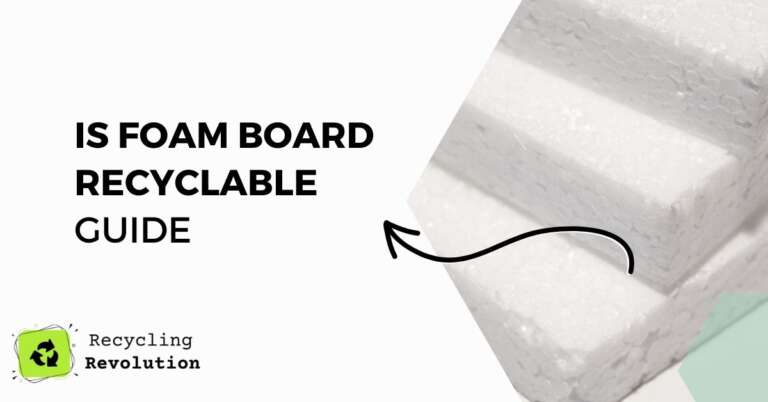Foam board is made of different types of foam materials, including polystyrene and EVA. Some companies recycle their boards and some do not however with the push of a greener and emissions future many are being forced to follow suit.
If you are feeling unsure as to what to do with your old foam boards then this article will fill you with what the options you have.
What is Foam Board made of?
Foam board is a corrugated cardboard used for packaging, shipping, and storage. It’s made up of two layers: the top layer is corrugated or shaped like a series of small triangles with rounded edges; the bottom layer is smooth, like paper or plastic.
The two layers are separated by a material called “plasticizer” that allows them to stick together when forming into a sheet.
Foam boards are typically made in thicknesses ranging from 1/16-inch (1.6mm) to 3/8-inch (9mm). Thicknesses over 1/4 inch can be too heavy to handle easily, especially when combined with other materials like tape or strapping.
For this reason, many companies use foam boards that are 1/8 inch thick or less, which makes shipping and handling easier than if they were thicker.
| Type of Foam Board | Properties | Common Applications |
|---|---|---|
| Polystyrene foam board | Lightweight, low cost, easy to cut, good insulation properties | Presentation backing, insulation |
| Polyurethane foam board | Lightweight, durable, good insulation properties | Insulation, building material, props and scenery for theater and film |
| Polyethylene foam board | Strong, flexible, water-resistant, good insulation properties | Packaging, flotation devices, construction and industrial applications |
Can Foam Board Be Recycled?
Foam board can be recycled, but it is not widely accepted by recycling facilities due to the difficulty of separating the foam from the paper or cardboard. Some facilities that specialize in recycling rigid plastics, such as EPS (expanded polystyrene), may accept foam boards. It is important to check with your local recycling program to see if they accept foam boards before attempting to recycle them.
Alternatively, some organizations and companies have started to collect and recycle foam boards by grinding them and converting them into pellets that can be used to make new products. Another option is to reuse the foam board, such as a base for new projects or as insulation in construction.
How To Recycle Foam
Look for a recycling program that accepts foam: Check with your local recycling program or waste management facility to see if they accept foam products for recycling. Some facilities may accept expanded polystyrene (EPS) foam, such as packing peanuts and foam packaging, while others may not.
Find a foam recycling facility: Some companies specialize in recycling foam materials and will accept foam products from individuals or businesses. You can search online for foam recycling facilities near you.
Prepare the foam for recycling: Clean the foam of any dirt or debris and remove any non-foam materials, such as tape or labels. Compress the foam to save space and make it easier to transport.
Drop off the foam at a recycling facility: Take your prepared foam to a recycling facility or foam recycling center. Some facilities charge a fee for recycling foam, while others accept it for free.
Reuse foam products: Instead of recycling, consider reusing foam products. For example, foam packing peanuts can be used to cushion fragile items during shipping, and foam packing materials can be used for insulation or as cushioning for furniture.
Contact local organizations and companies: Some organizations have started collecting and recycling foam. They may have a program to collect and recycle foam products.
How To Reuse an Old Foam Board
There are many ways to reuse an old foam board, including:
- Use it as a cutting surface: You can use foam board as a cutting surface for crafting projects, such as paper mache or origami.
- Use it as a background for photography: You can use foam board as a background for photography, especially for product or food photography.
- Use it as insulation: You can use foam board as insulation in your home by cutting it to fit around windows or door frames.
- Use it as a sign or bulletin board: You can use foam board as a sign or bulletin board by attaching fabric, paper, or other materials to it.
- Use it as a prop: You can use foam board as a prop in plays, movies, or TV shows.
- Use it as a base for a DIY project: You can use foam board as a base for a DIY project, such as building a model or a diorama.
Additional Tips
Here are some safety and legal tips on how to recycle foam board:
- Check with your local recycling program to see if they accept foam boards. Many programs do not accept it, so it may need to be disposed of as regular trash.
- If foam board is accepted, it should be clean, dry, and free of other materials, such as tape or labels.
- If you plan to recycle foam boards on your own, you should use a specialized foam board recycling machine.
- Always wear proper personal protective equipment when handling foam board, such as gloves and goggles.
- It is illegal to dispose of foam boards in landfills in some states and cities, so be sure to check your local laws before disposing of them.
- Check for a recycling program that specializes in foam board recycling.
- You can also consider repurposing foam boards for different projects.
FAQs
How should I prepare a foam board for recycling?
The foam core should be removed from the paper or cardstock before recycling. The paper or cardstock can then be recycled as normal, and the foam core can be taken to a facility specializing in recycling foam.
Are there any alternatives to recycling foam boards?
Yes, foam board can be reused instead of recycled. For example, it can be used as insulation or as a backing for artwork. Another alternative is to use more environmentally-friendly materials, such as paper-based alternatives or biodegradable foam.
How can I find a recycling facility that accepts foam boards?
You can contact your local recycling facility or waste management company to inquire about their policies on foam board recycling. Some companies that specialize in recycling foam may also be able to accept it.
Conclusion
There is no doubt that foam boards can be used for recycling. Whether foam board becomes a more popular product than it already depends on people’s attitude towards recycling waste.
There are many charities and activists who have worked to reduce the amount of waste we produce. We hope this guide helps people recycle their waste in a more environmentally friendly way.

